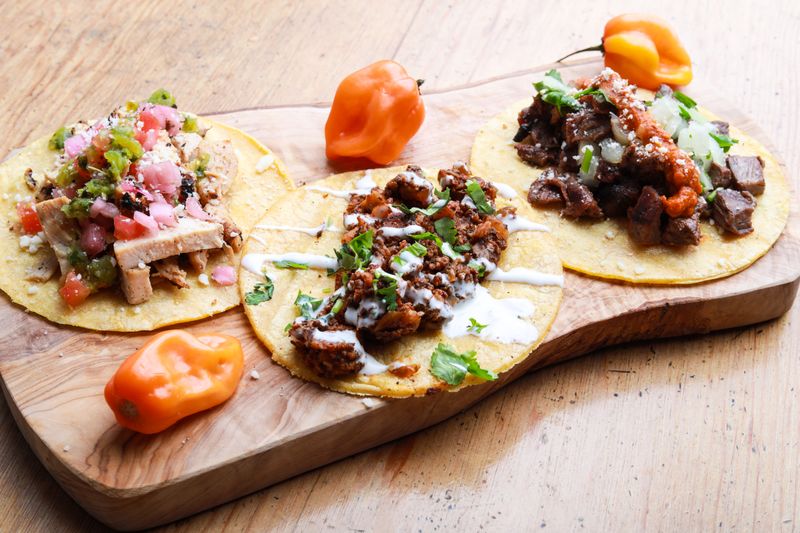
Resting there, on a plate, humbly, it waits to be eaten in two or three bites and hear a voice to plead for another. Simply, it is a meat or vegetable on top of a corn tortilla garnished with hot salsa, a sprinkle of juice squeezed from a lime, and, sometimes, minced onion and cilantro. Its name—Taco. Its virtue—to be the most common and popular dish in Mexico and, probably, the most internationally known one. In the morning, in the afternoon or at night, as a snack or as a meal, as a weekend night’s ritual with family or friends, or in parties as a taquiza, tacos come to the rescue. They are the heaven of hungers, a banquet for poor and rich.
Taco refers to a corn tortilla wrapping almost anything: fried or grilled chicken or steak, marinated pork slowly roasted in an upright grill, lamb or beef cooked in a pit two or three feet deep, insects, fish, shrimp, beans, salad cactus, mushrooms, and an infinite variety of guisados, as stews are called. Even a pinch of salt on a warm tortilla can be a taco.
Some might wonder why Mexicans are crazy about tacos; what makes them so special? I cannot remember when I started eating them, all I can say is that they became a drug, a medicine, a sort of happiness after a tough day. That is what they mean for most Mexicans; they are what pizza is to Italians. There is no place in the whole country without tacos. They are indispensable, inevitable, and vital. They are so loved that the word became synonymous for food. People say, “I am going to eat a taco” meaning “I am going to grab something to eat,” or they ask, “Do you want a taco?” when they share their food.
Understanding that every food can become part of a taco if it is placed on a tortilla, it is possible to see that the tortilla is the essential part of it, it is the key, the base that holds harmoniously the mix of flavors together. Without tortillas tacos would not exist. The magic of tortillas, their delightful and subtle taste of corn, comes from nixtamalization, its cooking process. A very old recipe, probably given to the Aztecs by their Gods, transforms the hard and dry kernels into a soft dough. The process is simple: kernels are cooked in water with some tablespoons of lime; yes, the lime used in construction, the one known as quicklime. The result of this is called nixtamal. After being cooked, the kernels are washed and ground into a dough—white, yellow or blue, depending on the type of corn—ready to be placed in an iron press to be molded into round and flat disks laid immediately on a hot griddle. As soon as each disk touches the hot iron surface an amazing smell excites the brain giving it the expectation of placing the source of that smell into the mouth.
Times have changed for tortillas, though, since the invention of the automated tortilla machine in 1947, which can produce about 50 tortillas per minute. Although these tortillas are not as good as the handmade ones, they are produced every day. The smell of corn coming from a tortillería is a sign of their freshness. When hand making, the process requires precision as the most refined culinary art: each side needs to be cooked for about one minute to allow the steam to puff up the tortilla and divide it into a thin and a thick layer, which indicate the interior and the exterior of the taco, respectively. In the words of the Mexican poet Salvador Novo, “The tortilla bulges as if it had come alive, as if it wished to fly, to ascend; as if Ehécatl had breathed into it. This is the time to gently lift it from the comalli, when it has, on the flesh of our flesh, of our sustenance, a second, delicate epidermis.”
This peculiar maize food is the basis of Mexican cuisine and diet, which explains why the average Mexican consumes around 135 pounds of tortilla per year! Although the size of a regular tortilla is 6 inches, when it comes to real tacos, those sold in taquerías or in the streets, tortillas tend to be smaller, usually 4 inches, the perfect size to cuddle the right amount of meat, fat and toppings to be eaten in a couple of bites.
Tacos’ exoticism comes not only from the stuffing but from the way they are eaten: first, once the filling is chosen, a garnish comes to compliment the texture of flavors adding a pinch of sourness and spiciness with pickled onion salad, guacamole or pico de gallo, tomato, green tomatillo, or guajillo salsa, and finally some drops of juice from a lime. There is only one way to eat a taco: holding it with the hands, no matter how fancy the restaurant is, for tortilla substitutes all utensils. The greatest experience, however, is found on the streets and taquerías where tacos are surrounded by the uniqueness of a wide variety of meats, stews, and salsas. Standing up with a plate carefully balanced on a hand, eating tacos on the streets can be a fun and risky adventure. Waiting in a line to possibly suffer indigestion, or even “the Moctezuma revenge”, can be worth it to try those tacos acclaimed by the whole a neighborhood.

Julia Negrete is a Spanish language instructor at Berges Institute.